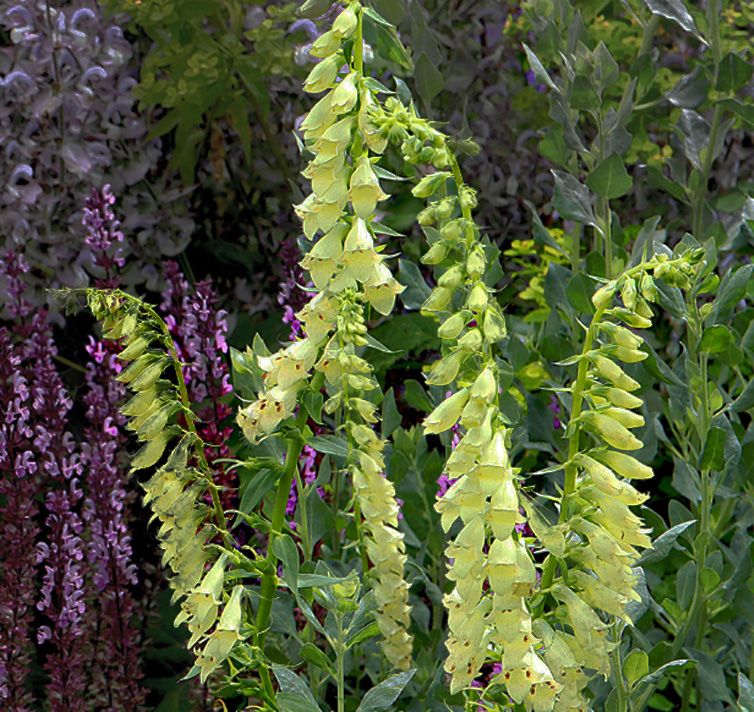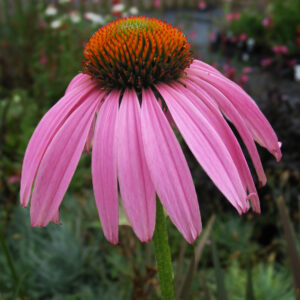- 1-9 pkts $4.50
- 10 pkts FREE
- Express post $12
Digitalis lutea
LEMON PERENNIAL FOXGLOVE
Digitalis lutea is a very different Foxglove – nothing like the traditional English Foxglove (Digitalis purpurea).
Not permitted for entry into Tasmania.
Refined trumpets of delicate moonlight-lemon
The blooms of Digitalis lutea are slender and refined little trumpets – compared to the big, blowsy gloves of usual Foxgloves.
And delicate creamy-lemon in colouring.
Showy without being coarse
But don’t worry – though each flower is slender, each 60cm. spire has loads of them.
And there are multiple spires produced over a long blooming period – so it makes a show without being loud and brassy.
Graceful spires
The flower spires also slender and graceful.
With each clump continuing to produce repeat multiple stems (especially when deadheaded).
Digitalis lutea blooms in spring – summer, then remains as an evergreen clump of neat, low foliage year round.
Perennial on duty all year – for many years
Digitalis lutea really is a different Foxglove.
Instead of being a biennial (relying on self seeding for future years); it is a very reliable, evergreen perennial.
So it remains for many years as a permanent, low, neat foliage clump.
Producing its slender flower spires every spring-summer.
For many years, year after year.
More heat & dry hardy than traditional Foxgloves
Digitalis lutea is native to areas around the Mediterranean, such as Greece and Turkey, as well as in Northern Africa.
So it is no stranger to heat and dry.
Tolerant of dry shade
It is native to scrub and woodland areas.
So prefers positions under trees and shrubs, in Part-Shade / Shade / Dappled Light / Sun for part of the day. Or in areas shaded by buildings.
Water-wise & dry hardy
Once the young plant is established in its spot, this hardy perennial becomes more drought tolerant than most other Foxgloves, and naturally able to cope with periods of dry and heat.
As befits a native of the hot, dry areas around the Mediterranean.
Particularly when it has some mulch and leaf litter as per a woodland habitat.
So it is an ideal choice for gardeners with limited water supplies and some shade.
Suits most soils including clay
Plants that can cope with clay are few and treasured.
Though dainty Digitalis lutea will manage in just about any soil (providing it has the mulch and leaf litter it loves).
But it is particularly partial to clay-based soils.
Graceful cut flowers
The narrow trumpets of Digitalis lutea have quite waxy substantial texture,
Borne along much of the 60cm. spire, and all on one side.
So making flower spires very suitable for use in vases and bouquets, with a good vase life.
Foxgloves also help to preserve other flowers in the vase.
Foxglove tea was an old florist’s trick for sanitizing vase water and extending flower life.
Beloved by native bees & small pollinators
Little native bees and other tiny pollinating insects just delight in foraging safely amongst the slender, nectar-rich trumpets. As do small, native Honey-eating birds.
But loathed by rabbits & deer
However rabbits and deer give Foxgloves a wide berth, knowing that they are toxic if eaten.
Frost hardy Digitalis lutea
Digitalis lutea is robustly frost hardy – down to below -15°C.
Evergreen perennial that also self-sows
This hardy evergreen perennial will also gently self-sow new babies if you allow it and do not deadhead all the spires.
60cm. High in graceful spring-summer flower spires x 30cm. Wide low, neat, evergreen foliage clump.
Why are Foxgloves called Foxgloves ????
Because wicked fairies presented wily Mr. Fox with the flowers to wear on his feet – so he could sneak up quietly on his prey
SEED SOWING ADVICE: QUICK & EASY
Digitalis lutea suits beginners & gardening with kids
Sow at any time of year in punnets indoors, when suitable temperatures can be provided (15-20°C).
OR
Scatter directly in the garden in late winter-early spring.
Sow Indoors for early plants: First sow the seeds in a punnet on the surface of good quality seed raising mix.
Now gently pat the seeds to the surface to ensure good contact.
Then barely cover with mix or fine sandy grit – because these seeds need light to germinate.
So not cover deeply.
Now thoroughly moisten the sown punnet by standing it in a shallow water bath.
And allowing the moisture to percolate up to the surface of the mix from below.
Then place punnet in a warm, well-lit position (not in any direct sunlight).
Temperatures of 15-20°C approx. are best for rapid and optimum germination.
You can use a heat mat if you have one, but it is not essential as these seeds are quick and willing germinators.
Continue to keep consistently moist by misting regularly from a spray water-bottle.
Placing a plastic lid or bag over the sown punnet will help to maintain consistent moisture.
Seedlings emerge in approx. 14-21 days.
Seed Count: 300 seeds per pack approx.
(We always aim to exceed the stated seed count and give a generous serve).
Click here for Nursery Open Days & Open Gardens Information
https://www.gardivalia.com.au/open-gardens
Click here to go back to Seeds Shop
https://www.seedscape.net.au/shop/
Related products
-
Add to WishlistAlready In WishlistAdd to Wishlist
-
Add to WishlistAlready In WishlistAdd to Wishlist
-
Add to WishlistAlready In WishlistAdd to Wishlist
-
All
Dierama pulcherrimum
‘Rose Pink’
ROSE PINK
FAIRY FISHING RODS
SALE: Buy 1 get 2 packs
$5.00 AUD Add to cartAdd to WishlistAlready In WishlistAdd to Wishlist





